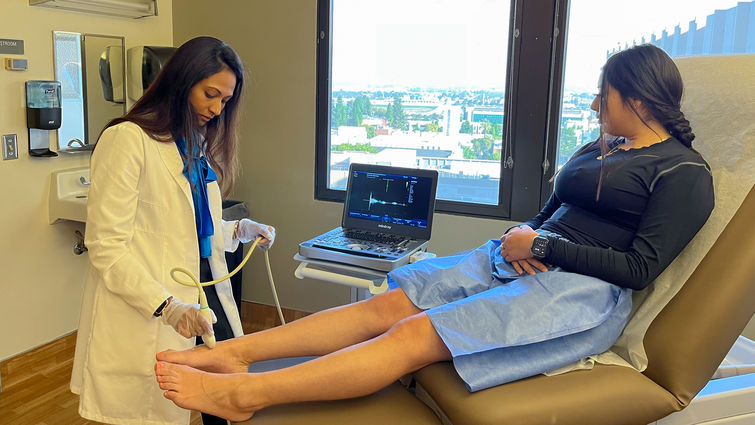

Pooja Swamy, MD, an interventional cardiologist and vascular specialist at Loma Linda University International Heart Institute, performs a vascular ultrasound on a woman’s leg. Ultrasounds are often used as a diagnostic and assessment tool for peripheral artery disease.
Peripheral artery disease (PAD) affects over 12 million Americans, according to the American Heart Association — meaning vessels that carry blood from the heart to the extremities (arms, legs, head, and neck) become narrowed or blocked.
Despite how commonly PAD exists among Americans, it is severely underdiagnosed, and those unfamiliar with its symptoms may delay seeking medical care until their disease has become severe, says Pooja Swamy, MD, an interventional cardiologist and vascular specialist at Loma Linda University International Heart Institute.
She says patients with severe PAD represent only the "tip of the iceberg" regarding how PAD manifests in individuals. For September’s Peripheral Artery Disease Awareness, Swamy submerges to reveal the rest of the iceberg by discussing lesser-known aspects of PAD’s pathology, symptoms, and risk factors.
PAD tends to overlap with coronary artery disease (CAD).
About a third of people with PAD also have coronary artery disease (CAD), says Swamy, because the risk factors are the same: smoking, high blood pressure, diabetes, and high cholesterol levels. CAD affects the arteries that bring blood to the heart, while PAD affects arteries that carry blood away from the heart to other parts of the body. She says the most common cause of both PAD and CAD is atherosclerosis — the buildup of fatty plaque in the arteries that narrows and blocks them throughout the body, including the heart, brain, arms, legs, pelvis, and kidneys.
“Those who recognize the shared risk factors between PAD and CAD can adopt lifestyle changes and seek medical attention earlier to prevent or better manage their heart health,” Swamy says. “The link between PAD and CAD highlights that our circulatory system is interconnected, and how important it is to seek comprehensive cardiovascular health.”
PAD symptoms differ for everyone.
Not everyone experiences PAD symptoms in the same way, says Swamy. The most common symptoms of lower-extremity PAD are cramping, fatigue, aching, pain, or discomfort in the arms, leg or hip muscles during movement or exercise, hair loss, poor wound healing, or discoloration of the toes or fingers.
However, Swamy says many patients — especially women — tend to experience different symptoms, such as general leg fatigue or heaviness. One large landmark study found that about half of women with significant cardiovascular disease did not raise their concerns with a doctor because they assumed their disease symptoms were part of the normal aging process. Compared to men, women generally present to the clinic when they are sicker from PAD, Swamy says.
“A lot of these women are also the ones who are the caregivers at home, so they kind of put their own health concerns on the back burner,” Swamy says. “Because women who do seek medical attention typically have severe PAD, they experience longer hospital stays and higher risk of mortality.”
Since the signs and symptoms of PAD can be subtle and varied, Swamy says the disease often goes underdiagnosed. People sometimes ascribe their symptoms to other conditions, such as arthritis or neuropathy, she says.
“If you see or feel anything unusual or new in your arms or legs, don’t make assumptions or brush it off. Talk to a doctor,” Swamy says. “If it turns out to be PAD, early diagnosis and intervention can significantly impact the course of the disease and improve overall quality of life.”
Healthy lifestyle habits help prevent or ease PAD.
Making healthy lifestyle choices plays a significant role in both PAD prevention and treatment, Swamy says. Preventing PAD involves quitting smoking, making healthy food choices, maintaining a healthy weight, and controlling any other conditions, such as diabetes, cholesterol levels, or high blood pressure.
If someone has already been diagnosed with PAD, Swamy says a healthy lifestyle bolsters the body and helps slow the disease’s progression. Regular exercise, like walking, improves blood flow throughout the body and can ease PAD symptoms. A healthy lifestyle can pair with any number of other treatments for PAD that patients may need.
Swamy is part of the International Heart Institute’s Peripheral Arterial and Venous Disease clinic — a multidisciplinary care team that screens, diagnoses, and treats patients with various conditions, including PAD. She says she has referred patients with PAD to the Cardiopulmonary Rehabilitation program to tailor heart-healthy exercise plans, understand their condition's risk factors and disease progression, and build good habits around nutrition.
Loma Linda University International Heart Institute care teams are committed to providing patients with compassionate, comprehensive, and personalized cardiovascular care. To learn more, please visit lluh.org/heart-vascular or call 1-800-468-5432 to make an appointment.

